Publication history
Swords & Spells was written by Gary Gygax, with art by David C. Sutherland III, and was published by TSR in 1976 as a 48-page digest-sized book. [1]
Swords & Spells was published by TSR, Inc. in 1976, the fifth and final supplement to the original Dungeons & Dragons boxed set, and is sometimes informally referred to as "Supplement V", with the official supplements Greyhawk and Blackmoor having been released in the previous year, and Eldritch Wizardry and Gods, Demi-gods & Heroes released previously in the same year. It does not, however, bear the official "Supplement V" designation on the cover, as "Gods, Demi-gods & Heroes" is stated in its introduction to be "the last D&D supplement." [4] Swords & Spells' product designation was TSR 2007.
The 45-page Swords & Spells has been billed as "The fantasy-based successor to Chainmail ," [5] and indeed is stated within the introductory text to be "the grandson of Chainmail." [2] The Chainmail rules originally formed the measurement and combat systems for the Dungeons & Dragons game, as the D&D rules could be cumbersome when conducting battles between armies. Improvisation was required, since D&D contained monsters and spells not covered in Chainmail. In Swords & Spells Gygax tried to fix this problem by introducing a diceless approach for large battles which averaged each monster's D&D statistics.
Swords & Spells proved unpopular, and its rules were discarded in later editions of D&D.
Reception
Robert R. Taylor reviewed Swords & Spells in The Space Gamer No. 11. [3] He commented that "S&S is extremely well done. The layout is excellent, the artwork is good and appropriate, and the rules are superb. They are written in a clear, easy style that allows for quick assimilation." [3] Taylor added that "The rules are particularly strong in one of the most difficult areas of fantasy miniatures - magic. The spell casting and spell chart make applying D&D magic to miniatures very simple and straightforward." [3] He also noted that the examples of magic in the sample game "helps in further clarifying this often nebulous area of fantasy wargaming". [3] He felt that "The other rules are equally logical and concise, and make S&S a highly recommended buy for someone just getting interested in miniatures wargaming." [3] Taylor concluded his review by saying, "Although the author (Gary Gygax) obviously spent a great deal of time and effort on these rules, especially the magic section, some concessions were made to allow for a more streamlined approach to miniatures. This reviewer found S&S to have a nice balance between complexity and playability. The staff of TSR should be congratulated for another fine piece of work." [3]
Lawrence Schick, in his 1991 book Heroic Worlds, described this book as "Sloppily produced, with some howling blunders in the rules." [1]
David M. Ewalt, in his book Of Dice and Men, commented that Swords and Spells "is the odd man out in the original D&D rule set. Rather than adding new details to the fantasy role-playing game, it takes a glance backward and provides rules for large-scale miniature war games that are merely based on Dungeons & Dragons. In his foreword, editor Tim Kask describes it as 'the grandson of Chainmail.'" [6]

Dungeons & Dragons is a fantasy tabletop role-playing game (RPG) originally created and designed by Gary Gygax and Dave Arneson. The game was first published in 1974 by Tactical Studies Rules, Inc. (TSR). It has been published by Wizards of the Coast, now a subsidiary of Hasbro, since 1997. The game was derived from miniature wargames, with a variation of the 1971 game Chainmail serving as the initial rule system. D&D's publication is commonly recognized as the beginning of modern role-playing games and the role-playing game industry, and also deeply influenced video games, especially the role-playing video game genre.

Ernest Gary Gygax was an American game designer and author best known for co-creating the pioneering tabletop role-playing game Dungeons & Dragons (D&D) with Dave Arneson.

TSR, Inc. was an American game publishing company, best known as the original publisher of Dungeons & Dragons (D&D). Its earliest incarnation, Tactical Studies Rules, was founded in October 1973 by Gary Gygax and Don Kaye. Gygax had been unable to find a publisher for D&D, a new type of game he and Dave Arneson were co-developing, so he founded the new company with Kaye to self-publish their products. Needing financing to bring their new game to market, Gygax and Kaye brought in Brian Blume in December as an equal partner. Dungeons & Dragons is generally considered the first tabletop role-playing game (TTRPG), and established the genre. When Kaye died suddenly in 1975, the Tactical Studies Rules partnership restructured into TSR Hobbies, Inc. and accepted investment from Blume's father Melvin. With the popular D&D as its main product, TSR Hobbies became a major force in the games industry by the late 1970s. Melvin Blume eventually transferred his shares to his other son Kevin, making the two Blume brothers the largest shareholders in TSR Hobbies.
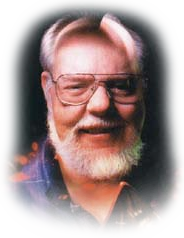
David Lance Arneson was an American game designer best known for co-developing the first published role-playing game (RPG), Dungeons & Dragons, with Gary Gygax, in the early 1970s. Arneson's early work was fundamental to the role-playing game (RPG) genre, pioneering devices now considered to be archetypical, such as cooperative play to develop a storyline instead of individual competitive play to "win" and adventuring in dungeon, town, and wilderness settings as presented by a neutral judge who doubles as the voice and consciousness of all characters aside from the player characters.

Blackmoor is a fantasy role-playing game campaign setting generally associated with the game Dungeons & Dragons. It originated in the early 1970s as the personal setting of Dave Arneson, the co-creator of Dungeons & Dragons, as an early testing ground for what would become D&D.

An owlbear is a fictional creature originally created for the Dungeons & Dragons fantasy role-playing game. An owlbear is depicted as a cross between a bear and an owl, which "hugs" like a bear and attacks with its beak. Inspired by a plastic toy made in Hong Kong, Gary Gygax created the owlbear and introduced the creature to the game in the 1975 Greyhawk supplement; the creature has since appeared in every subsequent edition of the game. Owlbears, or similar beasts, also appear in several other fantasy role-playing games, video games and other media.
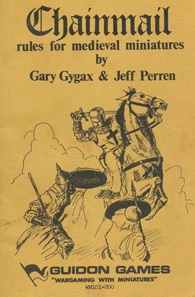
Chainmail is a medieval miniature wargame created by Gary Gygax and Jeff Perren. Gygax developed the core medieval system of the game by expanding on rules authored by his fellow Lake Geneva Tactical Studies Association (LGTSA) member Jeff Perren, a hobby-shop owner with whom he had become friendly. Guidon Games released the first edition of Chainmail in 1971.
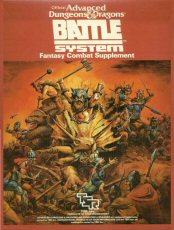
Battlesystem is a tabletop miniature wargame designed as a supplement for use with the Dungeons & Dragons role-playing game. The original Battlesystem was printed as a boxed set in 1985 for use with the first edition AD&D rules. For the second edition of AD&D, a new version of Battesystem was printed as a softcover book in 1989.

Kobolds are a fictional race of humanoid creatures featured in the Dungeons & Dragons roleplaying game and other fantasy media. They are often depicted as small reptilian humanoids with long tails, distantly related to dragons.
Guidon Games produced board games and rulebooks for wargaming with miniatures, and in doing so influenced Tactical Studies Rules, the publisher of Dungeons & Dragons. The Guidon Games publishing imprint was the property of Lowrys Hobbies, a mail-order business owned by Don and Julie Lowry. About a dozen titles were released under the imprint from 1971 to 1973.
Don Lowry is a wargamer, businessman, illustrator, and game designer who is best known as the publisher of Chainmail and the editor of Panzerfaust Magazine.
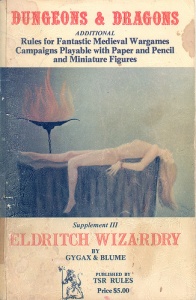
Eldritch Wizardry is a supplementary rulebook by Gary Gygax and Brian Blume, written for the original edition of the Dungeons & Dragons (D&D) fantasy role-playing game, which included a number of significant additions to the core game. Its product designation is TSR 2005.

Gods, Demi-Gods & Heroes is a supplementary rulebook for the Dungeons & Dragons (D&D) fantasy role-playing game. Its product designation is TSR 2006.

The original Dungeons & Dragons boxed set by Gary Gygax and Dave Arneson was published by TSR, Inc. in 1974. It included the original edition of the Dungeons & Dragons fantasy role-playing game. Its product designation was TSR 2002.
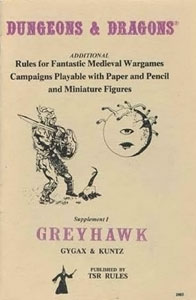
Greyhawk is a supplementary rulebook written by Gary Gygax and Robert J. Kuntz for the original edition of the Dungeons & Dragons (D&D) fantasy role-playing game. It has been called "the first and most important supplement" to the original D&D rules. Although the name of the book was taken from the home campaign supervised by Gygax and Kuntz based on Gygax's imagined Castle Greyhawk and the lands surrounding it, Greyhawk did not give any details of the castle or the campaign world; instead, it explained the rules that Gygax and Kuntz used in their home campaign, and introduced a number of character classes, spells, concepts and monsters used in all subsequent editions of D&D.

Blackmoor is a supplementary rulebook of the original edition of the Dungeons & Dragons fantasy role-playing game written by Dave Arneson.
Timothy James Kask is an American editor and writer in the role-playing game industry. Kask became interested in board games in his childhood, and later turned to miniatures wargames. While attending university after a stint in the US Navy, he was part of a group that playtested an early version of the new role-playing game Dungeons & Dragons (D&D) for game co-designer Gary Gygax. Gygax hired him as the first employee of TSR, Inc. in 1975. After editing some of TSR's early D&D publications, Kask became editor of The Strategic Review, which later became The Dragon, and then Dragon Magazine.
Jon Pickens is an American game designer and editor who has worked on numerous products for the Dungeons & Dragons fantasy role-playing game from TSR and later Wizards of the Coast.
Theron O. Kuntz is a game designer who was an early associate of Gary Gygax and employee of TSR.
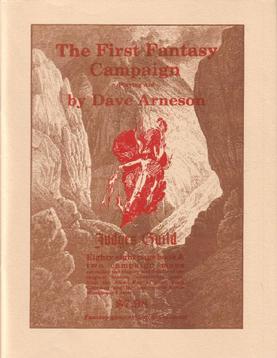
The First Fantasy Campaign is a supplement for fantasy role-playing games written by Dave Arneson and published by Judges Guild in 1977.














